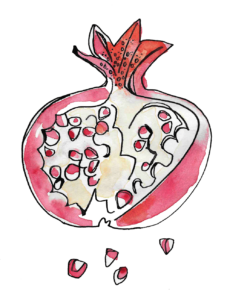by Janet Fletcher
I was a latecomer to fresh pomegranates, but I’ve been making up for lost time. I put their crunchy little arils in and on everything. (You probably call them ‘seeds’, but the proper name is ‘arils’.) Sprinkled on top of hummus or guacamole, those juicy arils glisten like ruby gems.
I have a pomegranate tree — the trees perform well in Napa Valley — and mine blooms profusely. For weeks it produces an eye-catching cloud of carmine-red blossoms. But the flowers set almost no fruit. Who said these trees do well in Napa? Clearly, I’m doing something wrong.
Fortunately, the growers who sell at the Napa Farmers Market are more successful. It’s fairly late in the pomegranate season, but I can still find the fruit fresh-picked at the farmers market, so I can postpone the inevitable. They will soon be gone for another year.
To obtain whole seeds, cut a thin slice off the top and bottom of the fruit without cutting into the arils. Then score the pomegranate from pole to pole as if you were going to quarter it but cut only skin-deep to avoid breaking the arils. Working over a bowl, break the pomegranate into quarters with your hands. Working with one quarter at a time, hold it skin side up in one hand, spreading your fingers a bit. With a wooden spoon, spank the skin side vigorously to release the arils. They will fall between your fingers and into the bowl. With your fingers, pry loose any arils that refuse to release (but most will). Discard any bits of white pulp in the bowl.
To obtain the juice, choose a pomegranate with no cracks. With the heel of your hand, roll the pomegranate around on a cutting board, pressing firmly to crush the internal sacs. You will hear the crackle of popping membranes. Keep rolling and pressing until the pomegranate feels like a deflated ball, taking care not to breach the skin or the juice (which stains) will squirt out. Hold the softened pomegranate over a bowl and, with a skewer, pierce it in one spot, releasing the juice into the bowl. Squeeze the pomegranate to obtain more juice. You should get about 1/3 cup.
Look for pomegranates that feel heavy for their size, which indicates that they have a lot of juice. If they have cracks or splits, so much the better. They tend to split open when they are fully ripe. You can keep them in a bag in the refrigerator for a couple of weeks but use them as soon as possible.
Add pomegranate arils to winter salads. I especially like them in a salad with escarole, radicchio, sliced fennel and avocado.
Add them to a cauliflower salad with avocado, red onion and cilantro.
Sprinkle with a little sugar and a dollop of yogurt and eat them for breakfast.
For a refreshing winter dessert, make a light sugar syrup and pour it warm over sliced navel oranges and pomegranates. Chill thoroughly.
Fresh pomegranate juice is precious because a single fruit doesn’t yield much. But it’s a fabulous cocktail ingredient, adding a splash of rosy color to a wine spritzer (white wine, pomegranate juice and sparkling water) or a margarita. Just in time for your New Year’s Day festivities, and for many cocktail hours ahead, here’s one of my favorite uses for pomegranate juice. Cheers!
Ruby Yacht
1/2 ounce (1 tablespoon) fresh pomegranate juice
1/2 ounce (1 tablespoon) simple syrup (recipe follows)
4 ounces (1/2 cup) Napa Valley sparkling wine, well chilled
1 orange twist
Chill a sparkling wine flute by filling it with ice water. Let stand 1 minute, then drain.
Put the pomegranate juice and the syrup in the flute. Top with sparkling wine. Add the orange twist and serve at once.
Makes 1 drink
Simple Syrup:
1/2 cup superfine sugar
Put the sugar in a small bowl and add 1/2 cup boiling water. Stir until the sugar dissolves and the syrup becomes clear. Chill thoroughly. Keep leftover syrup in a tightly covered container in the refrigerator for up to 2 weeks. Makes about ¾ cup.
Kids Activities at the Napa Farmers Market: Bring your youngsters to the market’s Education Station on Saturday, Jan. 5, for Story Time at 10:30 a.m.
On the KVYN Music Stage: James Patrick Regan will perform at the Napa Farmers Market on Saturday, Jan. 5.
Janet Fletcher is a Napa food writer and cooking teacher and the publisher of the Planet Cheese blog. She is on the board of directors of the Napa Farmers Market.

